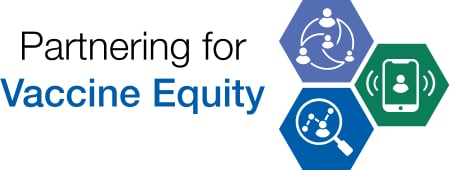Key points
- CDC’s Partnering for Vaccine Equity (P4VE) program equitably improves vaccination coverage through funded partnerships.
- Partner activities include engaging trusted messengers, holding vaccine clinics, and educating community members and healthcare providers.

Overview
CDC’s Partnering for Vaccine Equity (P4VE) program improves vaccination coverage across disproportionately affected populations through funded partnerships.
CDC launched the P4VE program in 2021 with supplemental COVID-19 funding. CDC awarded this funding to partners via cooperative agreements. The funding for the initial P4VE program focused on increasing COVID-19 and flu vaccine uptake for adults in racial and ethnic minority communities.
In 2024, CDC redefined the P4VE program to include all partners funded to address vaccine equity for both children and adults and across multiple priority populations. This shift allows the program to continue despite the loss of COVID-19 funding and many projects coming to an end. It is also more inclusive of the work that CDC’s funded partners are doing to address vaccine equity across all ages and various priority populations.
Work to advance vaccine equity for adults in racial and ethnic minority communities is still a critical part of P4VE. Partners work to increase coverage for COVID-19, flu, and other immunizations recommended by the Advisory Committee on Immunization Practices.
Impact
As of April 2024, P4VE partners have:
- Trained over 410,000 trusted messengers to conduct vaccine education and outreach in their communities
- Engaged more than 4 million people from racial and ethnic minority communities through promotional events
- Reached more than 572,000 clinicians and healthcare personnel through training and communication efforts
- Administered 2.4 million COVID-19 and flu vaccinations
- Launched 674 educational campaigns in 45 languages
Why it matters
There are many factors that create challenges to equitably increasing vaccination coverage for children and adults, such as:
- Education, income, and wealth gaps
- Job access and working conditions
- Racism and other forms of discrimination
- Gaps in healthcare access
- Transportation and neighborhood conditions
- Reimbursement (for adult vaccines)/cost
For example, CDC found that influenza, COVID-19, and respiratory syncytial virus (RSV) vaccination coverage in fall 2023 was lowest among uninsured adults1. Coverage was also lower for adults living in rural areas compared to those living in urban and suburban areas. COVID-19 and RSV vaccination coverage was higher among white adults than among most other racial and ethnic groups.
Our approach
Our approach to this work is guided by four overarching strategies:
- Funding partners to equitably improve vaccine access, confidence, and demand
- Providing funded partners with the technical support needed to help achieve immunization goals
- Monitoring and evaluating funded partner activities to inform program improvement
- Raising program awareness and demonstrating program impacts
Partner activities include:
- Hosting community outreach events to spread awareness about vaccines
- Working within communities to train and leverage trusted messengers
- Partner with vaccine providers to identify locations and hold vaccine clinics
- Develop educational materials and launch communications campaigns to promote vaccination
- Evaluate and disseminate best practices
Sign up for our newsletter
To stay up to date with vaccine equity and partner news, sign up for our biweekly Partner Digest.
Selected publications
Program implementation
Yang C, Zajac J, Asif A, et al. Partnering for Vaccine Equity (P4VE) Program May 2021-March 2022. June 2024.
Piasecki AM, Hall DM, Zajac J, Miller SA, Nilson JR. A programmatic update on COVID-19 vaccination in rural communities in the United States. Vaccine. April 2024. doi: 10.1016/j.vaccine.2024.04.043.
Urban Institute. Advancing vaccine equity through community-based organizations. March 2024.
Fiebelkorn AP, Adelsberg S, Anthony R, et al. The role of funded partnerships in working towards decreasing COVID-19 vaccination disparities, United States, March 2021-December 2022. Vaccine. January 2024. doi: 10.1016/j.vaccine.2023.12.061.
Stone ND, Fiebelkorn AP, Guo A, et al. Challenges and opportunities during the COVID-19 vaccination efforts in long-term care. Vaccine. January 2024. doi: 10.1016/j.vaccine.2023.12.064.
Ashenafi SG, Martinez GM, Jatlaoui TC, et al. Design and implementation of a federal program to engage community partners to reduce disparities in adult COVID-19 immunization uptake, United States, 2021-2022. Public Health Rep. December 2023. doi: 10.1177/00333549231208642.
Koppaka R, Wharton M, Lindley MC, Kohli J, Morita J. Increasing equity in adult immunization through community-level action. Health Aff Sch. December 2023. doi: 10.1093/haschl/qxad071.
Association of Immunization Managers. Lessons learned report: national environmental scan. November 2023.
Association of Immunization Managers. Lessons learned report: building vaccine equity for COVID-19 and flu vaccination in REACH communities. November 2023.
Disparities in vaccination
Hill YA, Yankey D, Elam-Evans LD, et al. Declining in vaccination coverage by age 24 months and vaccination inequities among children born in 2020 and 2021 — National Immunization Survey-Child, United States, 2021-2023. MMWR Morb Mortal Wkly Rep. September 2024.
Valier MR, Yankey D, Elam-Evans LD, et al. Vital Signs: trends and disparities in childhood vaccination coverage by Vaccines for Children program eligibility — National Immunization Survey, United States, 2012-2022. MMWR Morb Mortal Wkly Rep. August 2024.
Black CL, Kriss JL, Razzaghi H, et al. Influenza, updated COVID-19, and respiratory syncytial virus vaccination coverage among adults — United States, fall 2023. MMWR Morb Mortal Wkly Rep. December 2023.
Haanschoten E, Dubendris H, Reses HE, et al. Disparities in COVID-19 vaccination status among long-term care facility residents — United States, October 31, 2022–May 7, 2023. MMWR Morb Mortal Wkly Rep. October 2023.
Elam-Evans LD, Jones CP, Vashist K, et al. The association of reported experiences of racial and ethnic discrimination in health care with COVID-19 vaccination status and intent — United States, April 22, 2021–November 26, 2022. MMWR Morb Mortal Wkly Rep. April 2023.
Saelee R, Zell E, Murthy BP, et al. Disparities in COVID-19 vaccination coverage between urban and rural counties — United States, December 14, 2020–January 31, 2022. MMWR Morb Mortal Wkly Rep. March 2022.
- Black CL, Kriss JL, Razzaghi H, et al. Influenza, updated COVID-19, and respiratory syncytial virus vaccination coverage among adults — United States, fall 2023. MMWR Morb Mortal Wkly Rep. December 2023.
